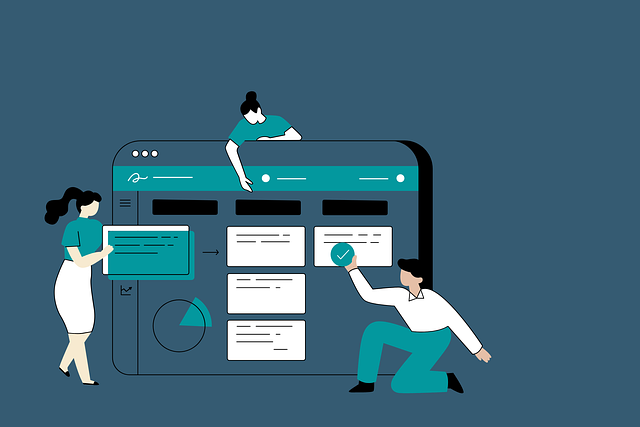Customer Relationship Management (CRM) tools are the backbone of modern sales and marketing strategies. They help businesses manage their leads, track customer interactions, and organize sales processes. However, even the best CRMs can become cluttered and inefficient if workflows aren’t optimized. This is where Artificial Intelligence (AI) steps in to transform how you handle your CRM workflows, ensuring leads move through your funnel effortlessly.
AI doesn’t just make your CRM smarter—it makes your entire process faster, more efficient, and highly personalized. From automating data entry to predicting lead behavior, AI-driven CRMs streamline every stage of lead management, enabling you to focus on closing deals. In this article, we’ll explore how to leverage AI to supercharge your CRM workflows for seamless lead conversion.
Let’s dive into actionable steps to make your CRM a lead-converting powerhouse.
Step 1: Automating Data Entry and Management
Eliminating Manual Data Entry
One of the most tedious tasks for sales and marketing teams is entering data into CRMs. Manually logging emails, calls, and customer details is not only time-consuming but also prone to errors. AI-powered CRMs eliminate this burden by automating data entry. They capture information directly from emails, meeting notes, and even social media interactions.
For example, an AI tool integrated with your CRM can automatically extract contact details from an email signature or log key points from a customer call. This ensures that your records are always up-to-date without requiring constant manual input. The result? More accurate data and more time for your team to focus on strategic tasks.
By automating data entry, you ensure no details are missed, creating a solid foundation for lead conversion.
Cleaning and Organizing Existing Data
Over time, CRMs can become cluttered with outdated or duplicate records, making it harder to track leads effectively. AI tools help by identifying duplicate entries, incomplete profiles, and inactive leads. They can merge duplicate records and suggest updates, keeping your database clean and reliable.
For instance, AI might flag two entries for the same contact created by different team members and merge them into a single, comprehensive record. This ensures your team always has a clear and accurate view of each lead.
A clean database improves efficiency, making it easier to nurture leads and convert them into customers.
Enhancing Data Enrichment
AI doesn’t just manage your data—it enriches it. By pulling information from external sources like LinkedIn, company websites, or industry databases, AI tools provide deeper insights into your leads. For example, they can add details like job titles, company size, or recent news about a lead’s organization.
This enriched data enables personalized interactions, as your sales team gains a deeper understanding of each lead’s needs and challenges. Personalization is key to building trust and moving leads through the funnel faster.
With AI-enhanced data, your team is always prepared for meaningful conversations.
Step 2: Prioritizing Leads with Predictive Analytics

Identifying High-Value Leads
Not all leads are created equal. Some are ready to buy, while others require more nurturing. AI-powered predictive analytics analyze a lead’s behavior, engagement history, and demographics to score them based on their likelihood to convert.
For example, if a lead frequently visits your pricing page, engages with your emails, and downloads case studies, AI can identify them as a high-priority lead. This allows your sales team to focus their efforts where they’re most likely to see results.
By prioritizing high-value leads, you ensure your team’s time is spent efficiently, increasing conversion rates.
Anticipating Lead Behavior
AI doesn’t just score leads—it predicts their next steps. Based on patterns in your CRM, AI tools can forecast whether a lead is likely to request a demo, attend a webinar, or even drop off the radar. This insight helps you take proactive measures to guide them toward conversion.
For instance, if AI predicts a lead is losing interest, it might recommend sending a personalized follow-up email or offering a limited-time discount. On the other hand, if a lead shows strong buying intent, AI might suggest scheduling a sales call immediately.
Predicting behavior allows you to stay one step ahead, ensuring no opportunities slip through the cracks.
Streamlining Follow-Up Strategies
AI takes the guesswork out of follow-ups by recommending the best time and channel for engagement. For example, if a lead consistently opens your emails in the morning, AI can schedule follow-ups during that window. If another lead responds better to phone calls, AI can notify your team to prioritize that method.
This level of precision ensures your follow-ups are always well-timed and relevant, increasing the likelihood of a response.
Smart follow-ups keep your leads engaged and moving through the funnel seamlessly.
Step 3: Personalizing Communication at Scale

Crafting Tailored Messages
Personalization is no longer optional—it’s expected. AI helps you deliver personalized communication at scale by analyzing each lead’s preferences, behavior, and needs. For instance, AI can suggest email content tailored to a lead’s industry or recommend talking points for a sales call based on their recent activity.
Imagine a lead downloads an eBook on “SaaS Trends for 2024.” AI can trigger a follow-up email thanking them for the download and suggesting a related webinar or case study. This kind of tailored messaging shows the lead you understand their interests, building trust and credibility.
Personalized communication creates stronger connections, increasing the chances of conversion.
Dynamic Content Recommendations
AI-powered CRMs can recommend dynamic content that adapts to each lead’s journey. For example, if a lead is in the early stages of research, AI might suggest sending educational resources like blog posts or infographics. For decision-stage leads, it could recommend testimonials or product demos.
These dynamic recommendations ensure your leads receive content that’s relevant to their stage in the funnel, keeping them engaged and informed.
By aligning content with lead intent, AI helps you nurture prospects effectively.
Automating Touchpoints
AI enables you to automate personalized touchpoints across channels. For example, it can send birthday greetings, follow up after a webinar, or even trigger a chatbot conversation based on specific actions. These touchpoints feel personal, even though they’re automated.
For instance, if a lead spends time on your FAQ page, AI might trigger a chatbot to ask if they need assistance or suggest booking a call with your team. This proactive approach keeps the conversation flowing, even when your team isn’t available.
Automation ensures consistent communication without sacrificing the personal touch.
Step 4: Enhancing Team Collaboration with AI Insights

Providing Real-Time Recommendations
AI doesn’t just benefit individual sales reps—it enhances team collaboration by providing real-time insights and recommendations. For example, AI can alert marketing teams about high-performing campaigns or notify sales teams about leads showing strong intent.
These insights create a feedback loop between teams, ensuring everyone is aligned and working toward the same goals. For instance, if marketing notices that leads from a specific campaign convert faster, they can prioritize similar strategies.
Real-time collaboration powered by AI ensures seamless lead management.
Centralizing Communication
AI integrates seamlessly with CRMs, consolidating all communication channels—emails, calls, meetings, and social media interactions—into a single platform. This centralization ensures that every team member has access to the latest updates on a lead’s progress.
For example, if a sales rep schedules a call, marketing can review the lead’s journey beforehand to provide relevant materials. Similarly, support teams can access the lead’s history to address any concerns during onboarding.
Centralized communication eliminates silos, fostering a cohesive approach to lead conversion.
Measuring Team Performance
AI-powered CRMs track team performance metrics like follow-up rates, response times, and conversion rates. These insights allow managers to identify areas for improvement and provide targeted training.
For instance, if AI detects that a team member struggles with closing deals, managers can provide coaching or suggest resources to help them improve. This ensures your team is always operating at peak performance.
AI-driven performance tracking keeps your team aligned and effective.
Step 5: Scaling Your AI-Driven CRM Workflows
Automating More Complex Workflows
As your business grows, so do your CRM needs. AI can handle increasingly complex workflows, such as automating lead scoring, nurturing, and handoffs between teams. For example, when a lead reaches a specific score, AI can automatically notify the sales team and schedule a call.
This scalability ensures your CRM adapts to your growth without losing efficiency.
Expanding Across Channels
AI-driven CRMs can integrate with multiple channels, from email and social media to chatbots and SMS. For instance, AI can ensure consistent messaging across platforms, making it easier to manage leads regardless of where they interact with your brand.
By expanding your workflows across channels, you create a seamless omnichannel experience for your leads.
Continuously Refining Strategies
AI learns and improves over time. Regularly review your CRM workflows and use AI insights to refine your strategies. For instance, if AI identifies a drop-off point in your funnel, you can address it with targeted interventions.
Continuous refinement ensures your workflows remain efficient and effective, driving consistent results.

Related: Check out our free tools:

Step 6: Real-World Applications of AI in CRM Workflows
Case Study: SaaS Company Reduces Lead Response Time
A growing SaaS company struggled with delayed lead follow-ups, often taking days to respond to inquiries. By integrating AI into their CRM, they automated the process of assigning leads to the right sales reps and prioritized follow-ups based on lead scoring.
AI identified high-priority leads in real time and automatically sent alerts to sales reps, complete with insights about the lead’s recent activity, such as downloaded resources or web page visits. The system also recommended follow-up content tailored to each lead’s interests, such as product demos or case studies.
The result? A 40% reduction in lead response time and a 25% increase in conversion rates. The team was able to engage leads when they were most interested, creating a more seamless and effective process.
E-Commerce Brand Enhances Cross-Selling with AI
An e-commerce brand used AI-driven workflows to maximize cross-selling opportunities. By analyzing customer purchase data and browsing behavior, the CRM suggested complementary products in real time. For instance, a customer purchasing running shoes might receive recommendations for socks, water bottles, or fitness trackers.
AI also automated email campaigns triggered by specific behaviors, such as abandoned carts. Customers received personalized messages featuring the items they left behind, along with similar products and limited-time offers.
These targeted workflows resulted in a 20% increase in average order value and a significant boost in customer satisfaction, as the recommendations felt relevant and helpful.
B2B Firm Streamlines Account Management
A B2B firm with a long sales cycle used AI to improve account management and nurture leads over time. AI helped segment leads based on industry, company size, and engagement level, ensuring tailored outreach for each account.
The CRM tracked all interactions—emails, meetings, and phone calls—and provided AI-generated insights on the best next steps. For example, if a lead consistently engaged with case studies but hadn’t scheduled a demo, the system suggested offering a free consultation. AI also monitored engagement trends, flagging accounts that needed re-engagement efforts.
These enhancements allowed the sales team to prioritize high-value accounts and close deals 30% faster, proving the power of AI-driven workflows in managing complex sales processes.
Step 7: The Future of AI in CRM Workflows

AI-Driven Conversational Interfaces
As AI technology evolves, conversational interfaces like chatbots and virtual assistants will play a bigger role in CRM workflows. These tools can engage leads instantly, answer questions, and even qualify prospects before handing them off to sales teams.
For example, a chatbot on your website could greet visitors, recommend resources based on their queries, and schedule meetings directly within the CRM. This seamless integration enhances lead engagement while freeing up your team to focus on high-value tasks.
The future of CRM workflows lies in dynamic, conversational AI that keeps leads engaged 24/7.
Predictive and Prescriptive Analytics
While predictive analytics forecasts lead behavior, prescriptive analytics takes it a step further by suggesting specific actions to achieve desired outcomes. For instance, AI might not only predict that a lead is ready to convert but also recommend offering a particular discount or bundling services.
This level of guidance ensures your team always knows the best approach to take, reducing guesswork and improving efficiency.
The combination of predictive and prescriptive analytics will make CRM workflows even more intelligent and actionable.
Enhanced Integration Across Tools
AI-powered CRMs are increasingly integrating with other tools, from marketing automation platforms to customer support systems. This unified approach ensures all departments have access to the same data, creating a consistent experience for leads and customers.
For instance, if a lead transitions from sales to support, AI can provide the support team with a detailed history of the lead’s journey, enabling faster issue resolution and a smoother handoff.
Enhanced integration will make CRM workflows more collaborative and streamlined across the organization.
Step 8: Overcoming Challenges in Implementing AI-Driven CRM Workflows

Addressing Resistance to Change
One of the most common hurdles in implementing AI-powered CRM workflows is resistance from teams accustomed to traditional methods. Employees may feel overwhelmed by new technologies or worry that AI will replace their roles. Overcoming this requires clear communication and a focus on how AI enhances their work, not replaces it.
Start by demonstrating the practical benefits of AI. For instance, show how automated data entry frees up time for strategic tasks or how predictive analytics helps identify high-value leads. Offer training sessions to familiarize your team with the AI tools and encourage feedback to address concerns.
When your team sees AI as a tool that empowers them rather than a threat, adoption becomes much smoother.
Ensuring Data Quality and Privacy
AI is only as good as the data it processes. Poor-quality data, such as duplicate records or outdated information, can lead to inaccurate predictions and ineffective workflows. Before implementing AI, clean and standardize your CRM data to ensure it’s reliable.
Additionally, prioritize data privacy and compliance. Clearly communicate how customer data is collected, stored, and used. Comply with regulations like GDPR or CCPA by incorporating features like consent tracking and data encryption into your CRM workflows.
By maintaining high data standards and prioritizing privacy, you create a strong foundation for effective AI integration.
Balancing Automation with Human Oversight
While AI automates many tasks, it’s important to maintain a balance between automation and human oversight. Over-automating workflows can lead to impersonal interactions or missed nuances in complex sales scenarios. For instance, while AI might recommend an email sequence, human input ensures the tone aligns with the brand’s voice and the lead’s expectations.
Set boundaries for automation, such as triggering manual reviews for high-priority leads or customizing templates for key touchpoints. This approach allows AI to handle repetitive tasks while your team focuses on building genuine relationships.
Balancing automation and human involvement ensures your workflows remain both efficient and personal.
Step 9: Scaling AI-Driven CRM Workflows Across Teams
Expanding Beyond Sales
AI-powered CRM workflows often start in sales, but their benefits extend across the organization. Marketing teams can use AI to identify audience segments and personalize campaigns, while support teams can leverage predictive analytics to anticipate customer needs and improve service.
For instance, if AI detects that a customer frequently engages with troubleshooting guides, it can alert the support team to proactively offer assistance. This integration ensures every department contributes to a seamless customer journey.
Scaling AI workflows across teams creates a unified strategy, improving overall efficiency and customer satisfaction.
Customizing Workflows for Different Segments
As your business grows, your audience becomes more diverse. AI can help customize workflows for different segments, such as industry-specific leads or geographic regions. For example, leads in the healthcare sector might receive tailored case studies, while international leads could be engaged with localized content.
Segment-specific workflows ensure every lead receives relevant, personalized attention, increasing the likelihood of conversion.
Customization at scale allows your CRM to adapt to the unique needs of different audience segments.
Monitoring and Refining at Scale
As AI workflows scale, continuous monitoring becomes critical. Use analytics to track metrics like response rates, conversion rates, and time-to-close across all segments and teams. Identify patterns of success and replicate them, while addressing underperforming areas with targeted improvements.
For instance, if a particular email sequence consistently drives engagement, integrate similar strategies into other workflows. Conversely, if a specific channel shows low ROI, refine or reallocate resources.
Regular refinement ensures your AI-driven CRM workflows remain agile and effective, even as your business evolves.
Step 10: Preparing for the Future of AI in CRM

Embracing New Technologies
The capabilities of AI in CRM are constantly evolving, with emerging technologies like natural language processing (NLP) and sentiment analysis poised to revolutionize workflows further. For example, NLP can analyze customer emails to identify emotions or intent, helping teams prioritize urgent issues or tailor responses.
Keep an eye on advancements in AI technology and be ready to integrate tools that enhance your CRM’s capabilities.
Staying ahead of trends ensures your workflows remain innovative and competitive.
Building Long-Term AI Strategies
AI integration isn’t a one-time project—it’s an ongoing strategy. Regularly evaluate your CRM goals and explore how AI can help achieve them. For instance, as your business grows, you might expand predictive analytics to forecast revenue or use machine learning to improve lead scoring accuracy.
Long-term strategies ensure AI continues to deliver value as your business needs evolve.
Investing in AI-Driven Culture
Finally, building an AI-driven CRM system requires an AI-driven culture. Encourage your team to embrace data-driven decision-making, explore AI-powered tools, and stay curious about how technology can enhance their workflows. Celebrate successes, such as improved response times or higher conversion rates, to reinforce the value of AI.
By fostering an AI-driven mindset, you create a culture of innovation that drives continuous improvement.
Conclusion: Transforming Lead Conversion with AI-Powered CRMs
AI-powered CRMs are revolutionizing how businesses manage and convert leads. By automating data entry, prioritizing leads, personalizing communication, and enhancing team collaboration, AI streamlines your workflows and maximizes efficiency. The result? Faster, smoother lead conversion and stronger relationships with your customers.
Whether you’re a small business or an enterprise, the time to integrate AI into your CRM is now. Start optimizing your workflows today, and watch as your leads move effortlessly through the funnel, turning into loyal, satisfied customers. The future of CRM is here—and it’s powered by AI.
READ NEXT:
- Are Vanity Metrics Killing Your Marketing Efficiency? Here’s What to Track Instead
- Pinpointing Digital Marketing ROI: Why Your Metrics Aren’t Telling the Full Story
- Unlocking Real ROI in Digital Marketing: The Hidden Costs Draining Your Budget
- How Misaligned Marketing Funnels Are Blocking Your ROI Potential
- Best Digital Marketing Agency In Santa Ana, California
- Best Digital Marketing Agency In San Francisco, California





















